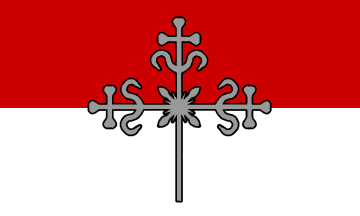
image by António Martins-Tuválkin, 11 September 2007

Last modified: 2008-06-28 by dov gutterman
Keywords: suiti people | latvia |
Links: FOTW homepage |
search |
disclaimer and copyright |
write us |
mirrors

image by António Martins-Tuválkin, 11 September 2007
See also:
Our colleague Ilmars Bite from Latvia, today on
RussoVex mailing list reported the flag of the religious minority
Suiti in Latvia. I searched around the link he provided and here
is what I found at <www.suitunovads.lv>:
"Suiti region has 2800 inhabitants, occupying 402 square
kilometers in the Western part of Latvia. Inhabitants of this
area call themselves "Suiti" and they are proud of
their distinct identity and character of their own.
History of Suiti goes back almost 400 years to a romantic story
in 1623. Reformation in Grand Douchy of Courland took place 1561, when duke
Gothard Ketler abandoned Catholic religion to become Lutheran. So
did also most of population in Courland. But in 1623
the local land owner, count Johan Ulrih fon Schwerin in order to
marry a Polish court lady Barbara Konarska agreed to become
Catholic. In that year he invited Jesuits to establish
a mission in Alsunga to help him transfer his peasants back to
Catholicism. He donated land to the Catholic
congregation and built a new church in Alsunga.
When trying to expand Catholic influence in the surrounding area
he run into a violent oposition from neibouring Lutheran land
owners which led to poisoning of Johan Ulrich fon Schwerin in
1636. In the same year Lutheran priest was finally
expelled from Alsunga and King of Poland Vladislav himself had to
intervene in order to calm down this Catholic - Lutheran
conflict.
Schwerin family sold their property in 1728, but by then it
already was a strong Catholic island surrounded from three sides
by traditionally Lutheran areas and from one side boardered by
the Baltic Sea. Enven though ir is not an island, for several
centuries it has practically functioned as a one. Marriages
across religious boundaries were strongly
discouraged. The region lived to a certain degree in a
religious, cultural and to some extent economic self-isolation.
This religious based self-isolation helped to preserve a very
rich traditional culture and customs, which in such a compact
area is unique for Latvia. For Latvian culture this
small Suiti region means its own national costume, its own
dialect, over 52 thousand recorded folk songs, very detailed
marriage and other customs, many of which are still today
practiced in the daily lives of Suiti.
Today Suiti region with its three Catholic churches, beautiful
sea coast, historic architecture, rural landscapes, rich forest
and natural resources and stubborn and independent minded people
has stood up against the wish of the central Government in Riga
to divide it into two parts and join to larger local government
entities of Kuldiga and Ventspils. Two
non-governmental organisations have been established in 2007 to
support preservation of Suiti self-government. We
think that protecting of our identity, which our ancestors have
brought through centuries, is at stake. We cannot
afford to lose it and we believe, that with the help of God we
will prevail."
The flag is shown here.
If I understand correctly, flag was aproved by Ministry Cabinet
on September 4th 2007 (but I can't understand which Ministry).
Valentin Poposki, 7 September 2007
The flag is 3:5 horizontal bicolor dark red over white with
overall a black-lined grey cross, with thin arms not reaching the
edges, all the same length, and all but the bottom arm decorated
with crosslet bottony and yokes (?), and a small filliform
four-ray saltire splendor at the heart of the cross, with eight
shorter secondary rays.
António Martins-Tuválkin, 11 September 2007
According to website, Suiti is now "novads" - a
district. But, according to plans for new municipal structure of
Latvia, Suiti will be divided. Ilmars also reported about the
protest of local population against government decision, trying
to preserve their own community. However, Latvia at the moment is
such a mess (from the aspect of local government territorial
division), so Suitu novads could be just a project. As far as I
know the existing Kuldigas rajons should be divided in three
novads - Kuldigas, Skrundas and Suitu.
Valentin Poposki, 12 September 2007
Suiti region is small catolic enclave in three rural parishes
in Kuldiga and Ventspils districts - Alsunga, Gudenieki and
partialy Jurkalne. In process of administrative reform they will
to form separate unit, this was not allowed, because population
is too small. Alsunga and Gudenieki are included in Kuldigas
novads, Jurkalne - in Ventspils novads. Flag is created for
people. Suiti don't accept the term "minority" - they
are one of etnographicaly diverse group of latvians. There are
many such groups - in Nica and Barta, Konini, Maliena, Ventava
and of course Latgale. Suiti are one of most active and well
known such groups and one of reasons is different confession. And
they are only such group what demanded separate administration -
others are with less power.
Gvido Petersons, 12 September 2007
The origin of the name came from the Finno-Ugric livonian
language suoisti which means people from the marsh.
Guy Babonneau, 19 September 2007